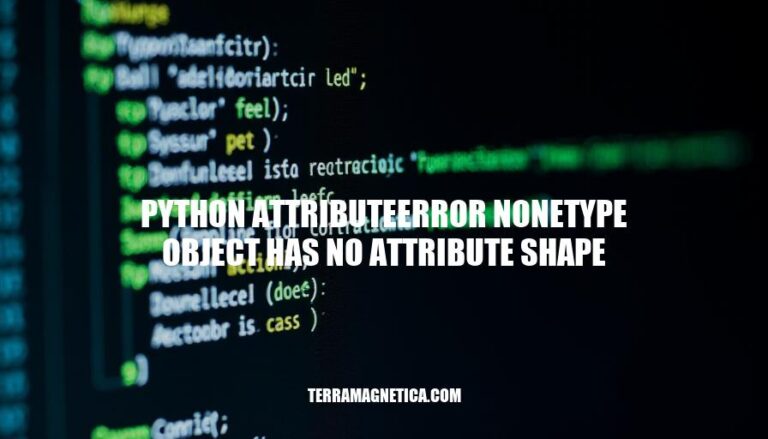


Encountering the ‘python attributeerror nonetype object has no attribute shape’ error can be quite frustrating in Python programming. This error typically arises when attempting to access the ‘shape’ attribute of a variable that is None, which indicates a variable or function did not return an expected object. Its significance lies in its ability to disrupt the execution of a program and impede the processing of data arrays, which are vital in fields like data analysis and machine learning.
Common occurrences include scenarios where image processing libraries like OpenCV or NumPy are used, and the intended object for manipulation is either not loaded properly or is null due to preceding code errors.
‘AttributeError’ in Python pops up when you try to use an attribute that an object doesn’t have. Here, ‘NoneType’ means the object is None (the absence of a value). This error signals that you’re trying to access the ‘shape’ attribute, commonly associated with NumPy arrays or similar, on a ‘None’ object.
‘NoneType’ is the type of None in Python.
An ‘object’ in Python can be data types, variables, functions, etc. An ‘attribute’ is a property or method of an object. In this case, ‘shape’ is the attribute, and it’s missing from the ‘None’ object you’re trying to manipulate.
Fixing this usually involves checking why the object is None before you attempt to access its attributes.
The ‘AttributeError: ‘NoneType’ object has no attribute ‘shape” in Python often occurs when you try to access the ‘shape’ attribute of an object that is ‘None’. This typically happens in scenarios like:
Attempting to call the ‘shape’ attribute on a ‘None’ object when reading files. For example, when using libraries like OpenCV:
import cv2
img = cv2.imread('non_existent_file.jpg')
print(img.shape)
In this case, cv2.imread returns None if the file doesn’t exist, leading to the error when img.shape is accessed.
Failing to return a valid object in functions. For example:
def get_data():
# some conditions that might cause return of None
return None
data = get_data()
print(data.shape)
Here, the function get_data returns None, resulting in an error when data.shape is accessed.
Incorrect use of libraries or wrong configurations. For instance, in NumPy:
import numpy as np arr = np.array(None) print(arr.shape)
This creates an array with None, which cannot have a ‘shape’ attribute.
Handling DataFrame operations incorrectly with Pandas:
import pandas as pd
df = pd.read_csv('empty_file.csv')
print(df.shape)
An empty or incorrectly read CSV file can lead to None, causing the ‘shape’ attribute access to fail.
Mismanaging API responses that return None:
response = some_api_call()
data = response.get('data')
print(data.shape)
If the API call returns None, trying to access ‘shape’ on data will trigger the error.
These scenarios illustrate why ensuring the object is not None before accessing its attributes is crucial for error-free code.
First, identify where the error occurs in your code by checking the traceback for the specific line.
Next, add print statements to check the flow of variables:
print(variable_name)
Check that the variable is not None before accessing its shape attribute:
if variable_name is not None:
print(variable_name.shape)
else:
print("variable_name is None")
Trace back to the point where the variable is assigned a value and ensure it’s properly initialized:
variable_name = some_function() print(variable_name)
Verify the function or method that assigns the value is returning what you expect:
def some_function():
value = some_other_function()
print("Value inside some_function:", value)
return value
If using libraries like NumPy or pandas, check the operations producing the variable:
import numpy as np array = np.array([1, 2, 3]) print(array.shape)
Remember to handle cases where the variable might be None:
def process(data):
if data is not None:
return data.shape
else:
return "Data is None"
Lastly, rerun the code and follow the print statements to ensure the variable flows correctly through the code and is not None when accessing the shape attribute.
Initialize Variables Properly: Before using variables, especially ones expected to hold data like arrays or images, ensure they are initialized correctly. If there’s a chance they could be None, initialize them with default values.
Use Conditional Checks: Implement checks to verify if the variable is None before accessing its attributes.
if variable is not None:
print(variable.shape)
else:
print("Variable is None")
Error Handling: Use try-except blocks to catch and handle exceptions gracefully.
try:
shape = variable.shape
except AttributeError:
shape = None
print("Variable has no attribute 'shape'")
Debugging: Insert print statements or use logging to trace and confirm that variables hold the expected values throughout the code.
Consistent Data Flow: Ensure that functions return consistent types. Functions should always return an empty object or a default value rather than None when they fail or don’t produce output.
Documentation and Code Comments: Include comments that detail expected data types and potential pitfalls. This helps in understanding and maintaining code.
By following these tips, you can avoid the pesky AttributeError and keep your code running smoothly.
The ‘AttributeError: ‘NoneType’ object has no attribute ‘shape” error in Python occurs when trying to access the ‘shape’ attribute of an object that is None, typically due to incorrect library usage, function returns, or data handling issues.
To resolve this, identify the source of the error by checking the traceback and adding print statements to verify variable values. Ensure variables are properly initialized, use conditional checks, implement error handling, debug code, maintain consistent data flow, and include documentation comments.
By following these tips, you can avoid this error and write more robust Python code.